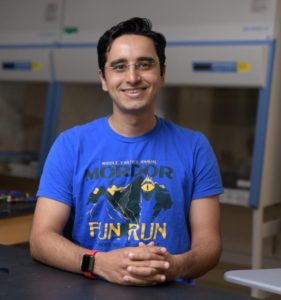 Saad Bhamla studies biomechanics across species to engineer knowledge and tools that inspire curiosity. Saad is an assistant professor of biomolecular engineering at Georgia Tech. A self-proclaimed “tinkerer,” his lab is a trove of discoveries and inventions that span biology, physics and engineering. His current projects include studying the hydrodynamics of insect urine, worm blob locomotion and ultra-low-cost devices for global health. His work has appeared in the New York Times, the Economist, CNN, Wired, NPR, the Wall Street Journal and more. Saad is a prolific inventor and his most notable inventions includes a 20-cent paper centrifuge, a 23-cent electroporator, and the 96-cent hearing aid. Saad’s work is recognised by numerous awards including a NIH R35 Outstanding Investigator Award, NSF CAREER Award, CTL/BP Junior Faculty Teaching Excellence Award, and INDEX: Design to Improve Life Award. Saad is also a National Geographic Explorer and a TED speaker. Newsweek recognized Saad as 1 of 10 Innovators disrupting healthcare. Saad is a co-founder of Piezo Therapeutics.
Saad Bhamla studies biomechanics across species to engineer knowledge and tools that inspire curiosity. Saad is an assistant professor of biomolecular engineering at Georgia Tech. A self-proclaimed “tinkerer,” his lab is a trove of discoveries and inventions that span biology, physics and engineering. His current projects include studying the hydrodynamics of insect urine, worm blob locomotion and ultra-low-cost devices for global health. His work has appeared in the New York Times, the Economist, CNN, Wired, NPR, the Wall Street Journal and more. Saad is a prolific inventor and his most notable inventions includes a 20-cent paper centrifuge, a 23-cent electroporator, and the 96-cent hearing aid. Saad’s work is recognised by numerous awards including a NIH R35 Outstanding Investigator Award, NSF CAREER Award, CTL/BP Junior Faculty Teaching Excellence Award, and INDEX: Design to Improve Life Award. Saad is also a National Geographic Explorer and a TED speaker. Newsweek recognized Saad as 1 of 10 Innovators disrupting healthcare. Saad is a co-founder of Piezo Therapeutics.
Find more about Saad’s work via:
Group website: The Bhamla Lab (gatech.edu)
@BhamlaLab
Read Saad Bhamla’s Emerging Investigator article http://xlink.rsc.org/?doi=10.1039/D3SM00542A
How do you feel about Soft Matter as a place to publish research on this topic?
I value Soft Matter highly; it has been my go-to for publishing significant works since my early days as a Ph.D. student in 2014 (first paper as a Ph.D. was in Soft Matter). The journal fosters visibility and collaboration in the diverse field of soft matter, a reason I have published four papers here and continue to return.
What aspect of your work are you most excited about at the moment and what do you find most challenging about your research?
I am particularly excited about our exploration of living worms (L. Variegatus and T. Tubifex in collaboration with the Deblais group), as a model to study entangled polymer dynamics, topology, and soft robotics. These organisms assemble into “worm blobs,” active three-dimensional entities that exhibit both solid and liquid properties, dynamically responding to stimuli such as light. This venture into the world of active, polymer-like entities opens up avenues to investigate a range of emergent behaviors, offering a rich experimental platform. The integration of diverse fields and communicating these interdisciplinary findings effectively remain substantial challenges.
In your opinion, what are the most important questions to be asked/answered in this field of research?
We are at a juncture where we are redefining principles of soft matter physics, incorporating activity into concepts such as entanglement and polymer rheology. The worm blobs stand as a promising experimental platform, urging us to revisit and potentially reshape the field by probing the physics of out-of-equilibrium polymers, a fascinating area with many questions to explore.
Can you share one piece of career-related advice or wisdom with other early career scientists?
I often remind my students to be the best versions of themselves, encouraging them to trust their scientific instincts and not to shy away from hard and seemingly impossible problems. As the saying goes, “The difficult we do immediately; the impossible takes a little longer.”










